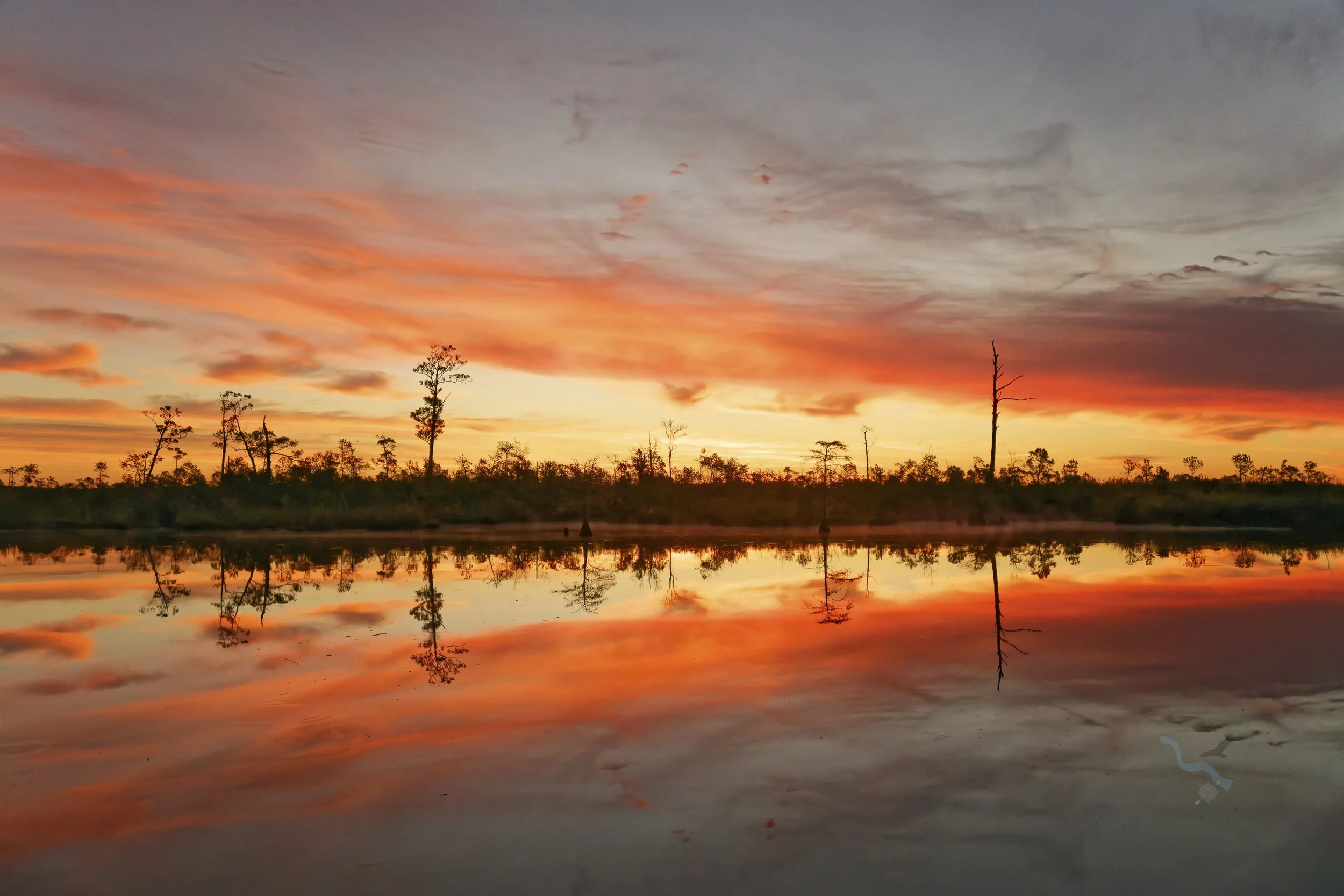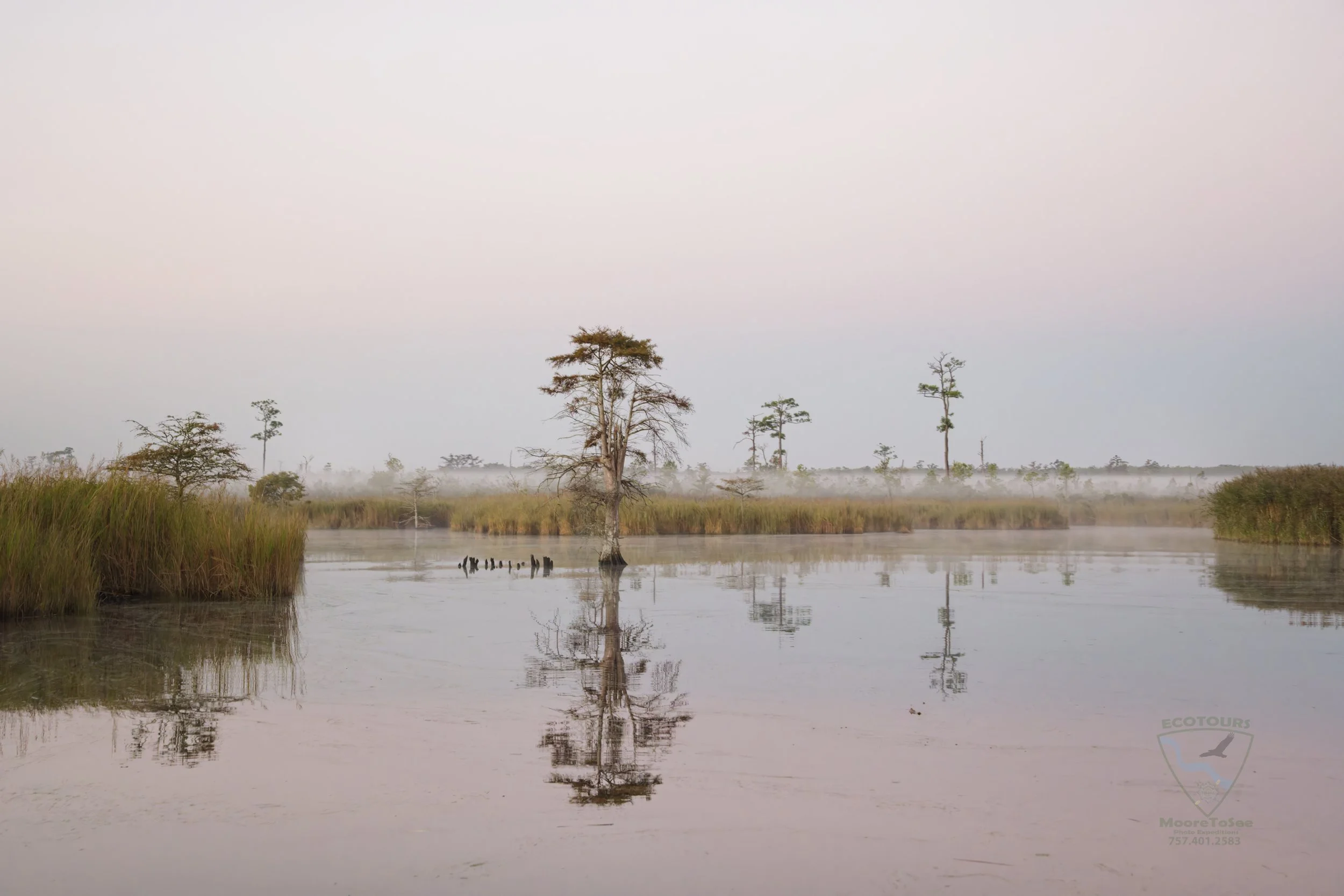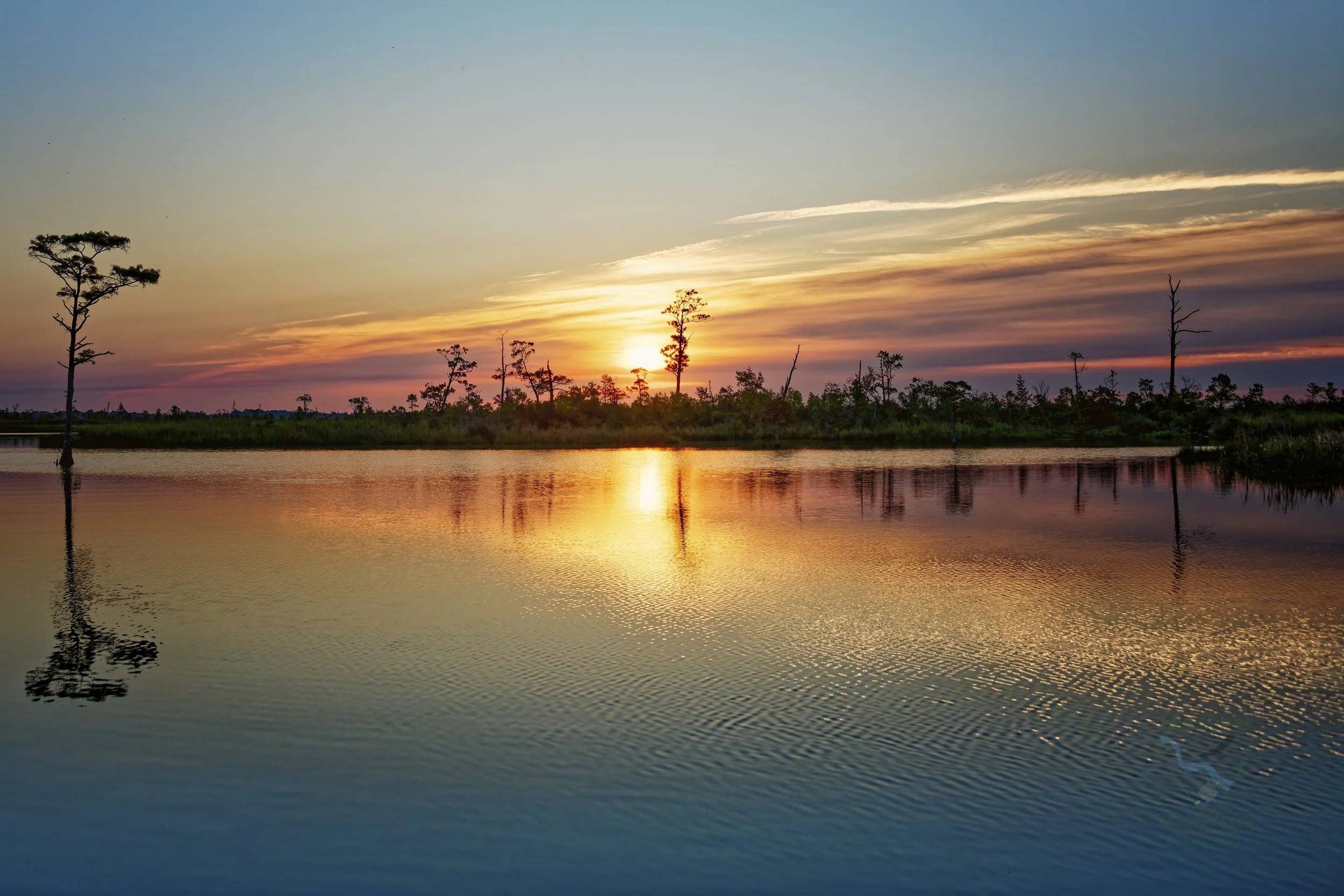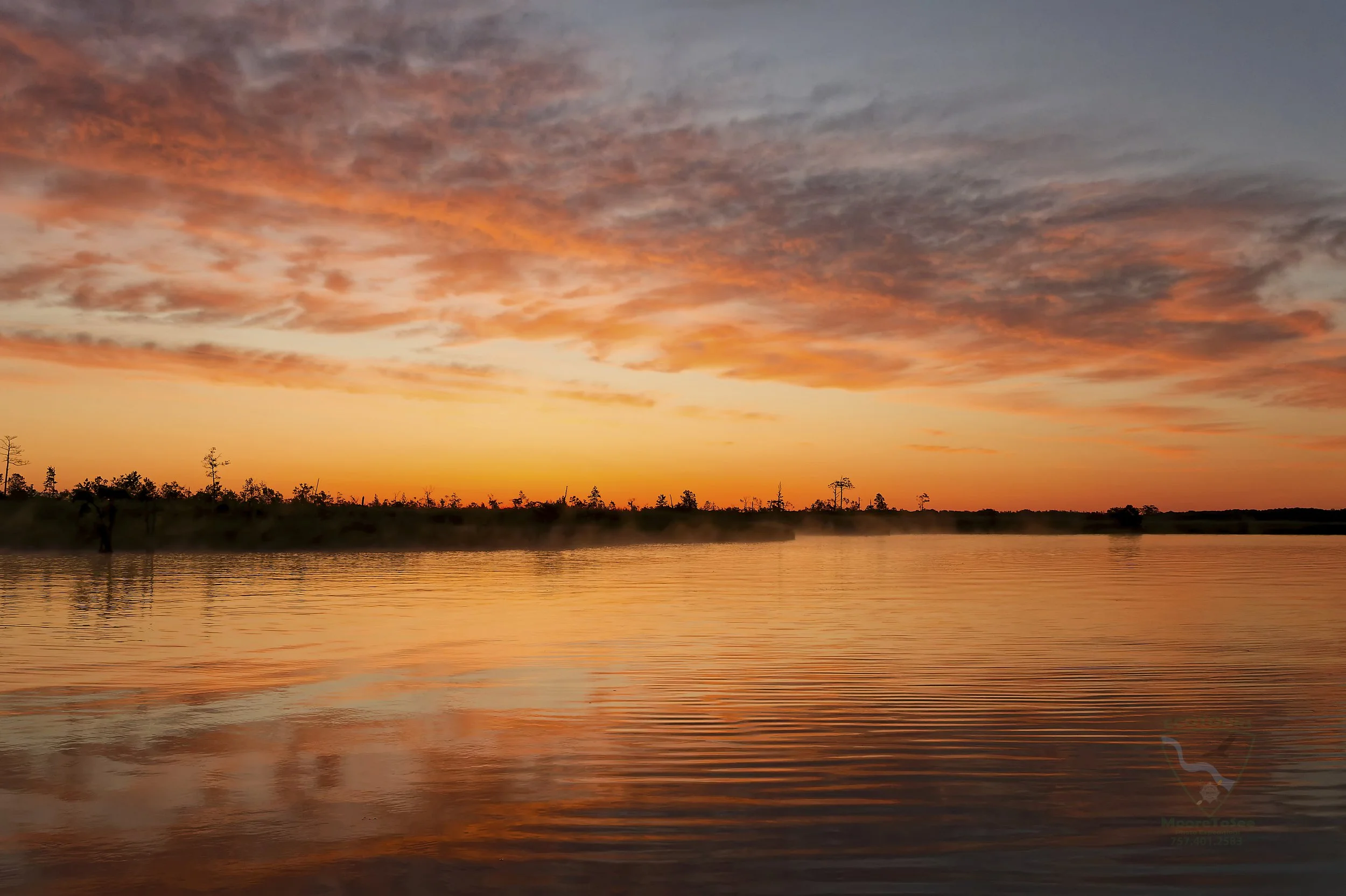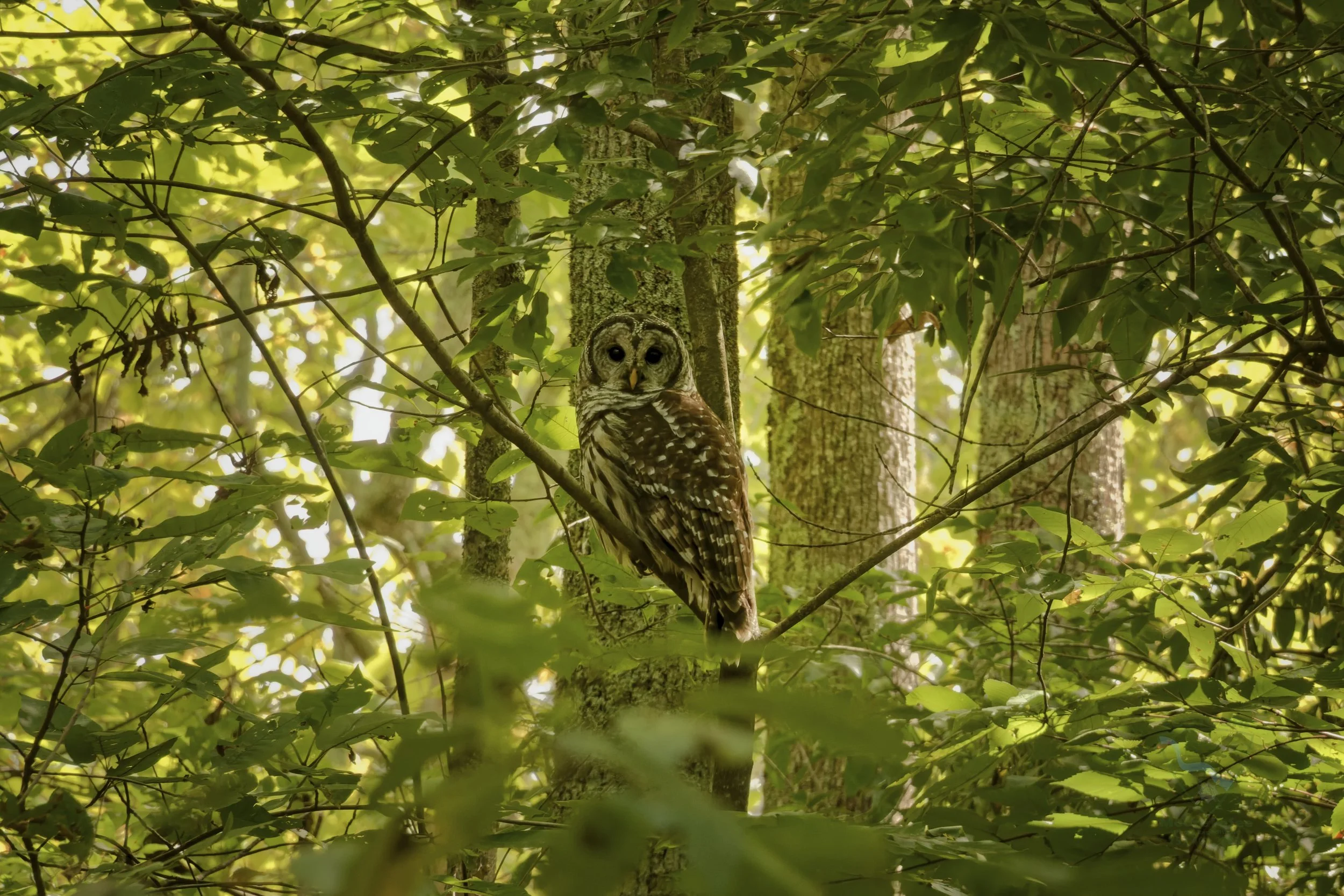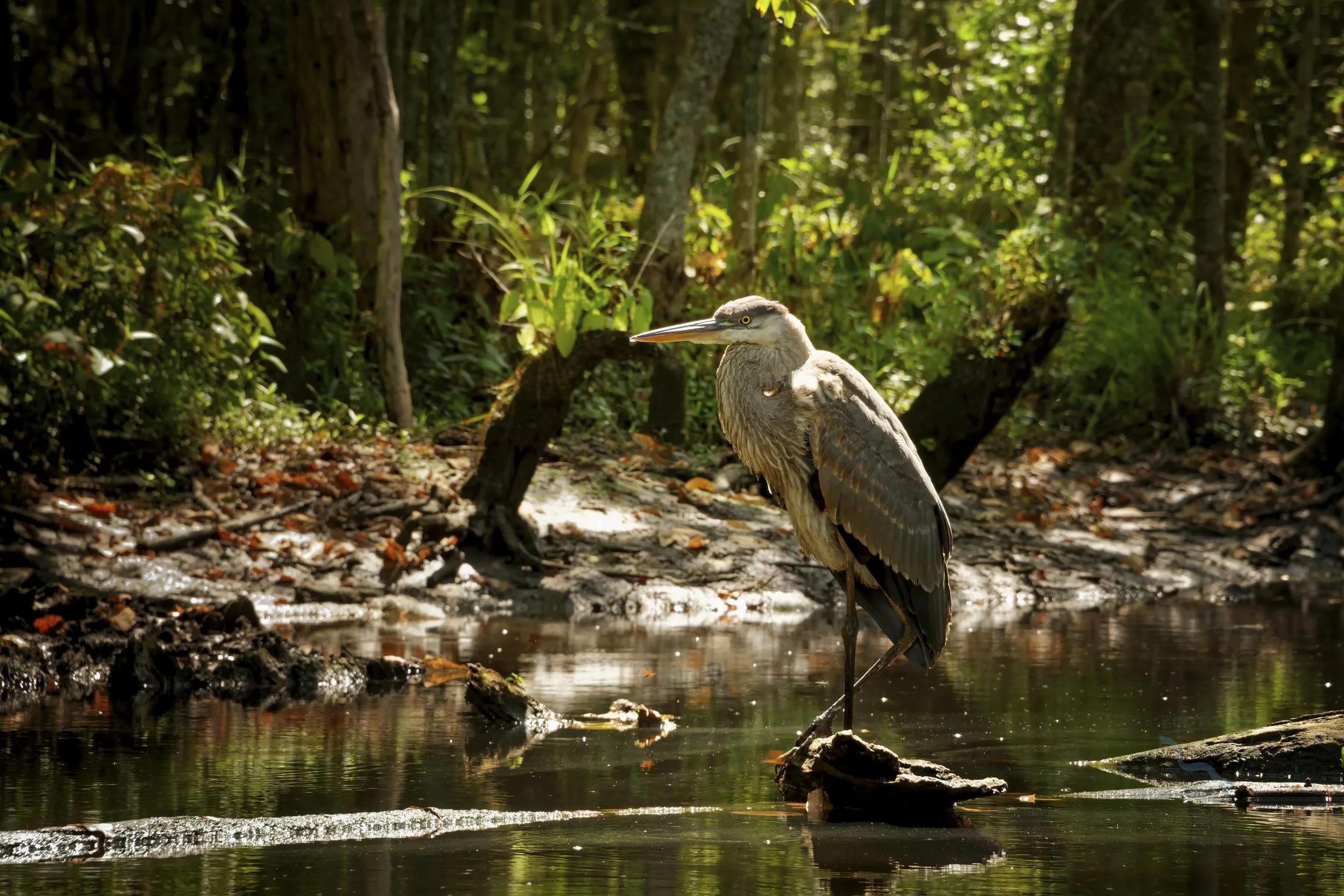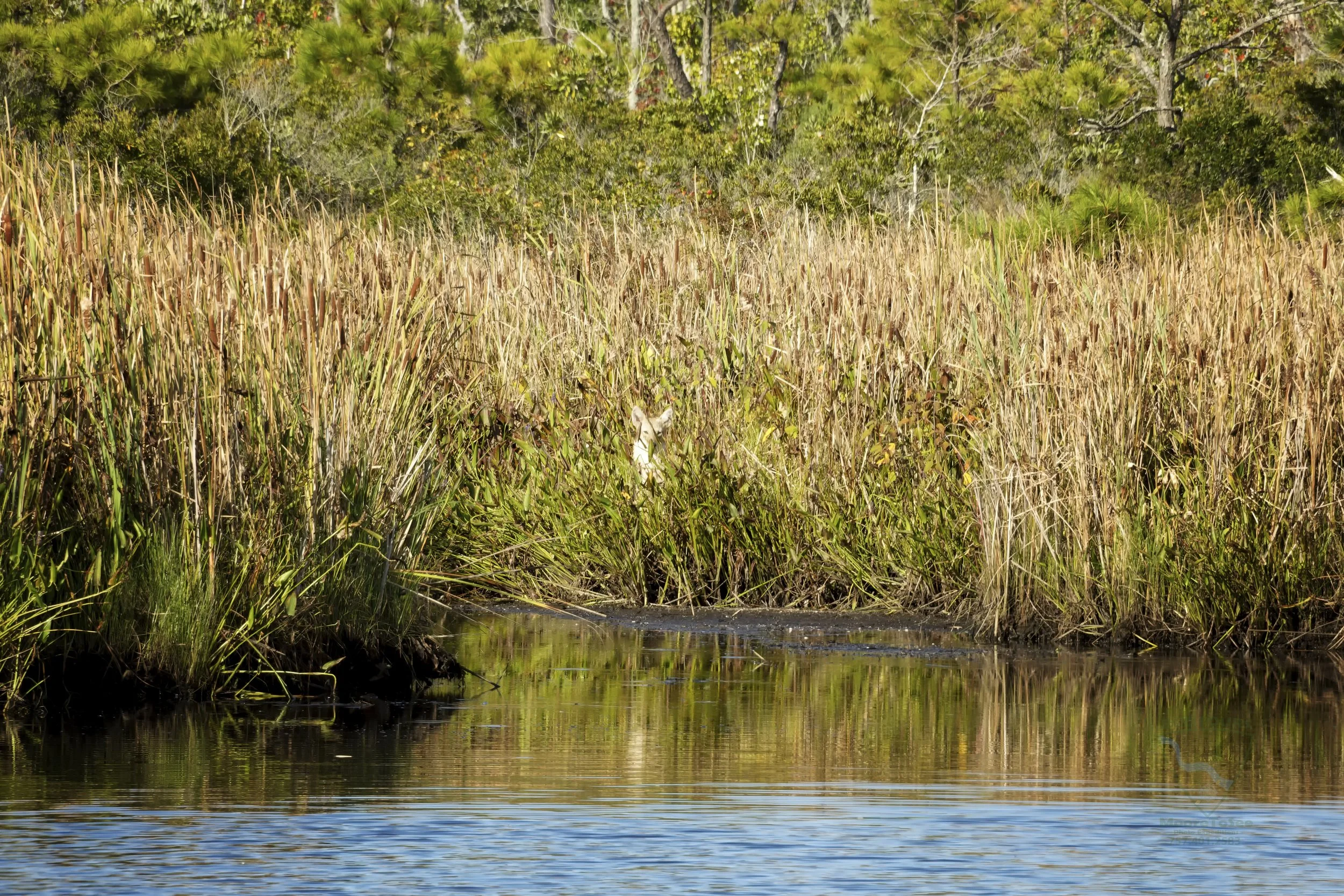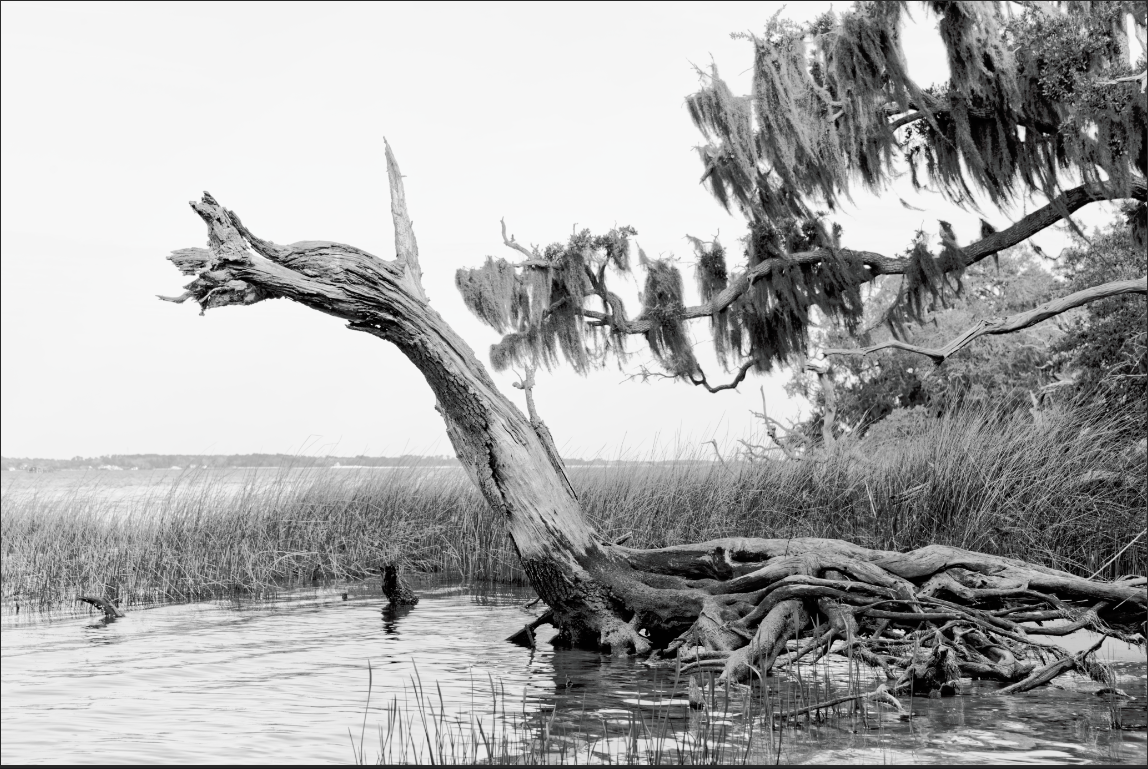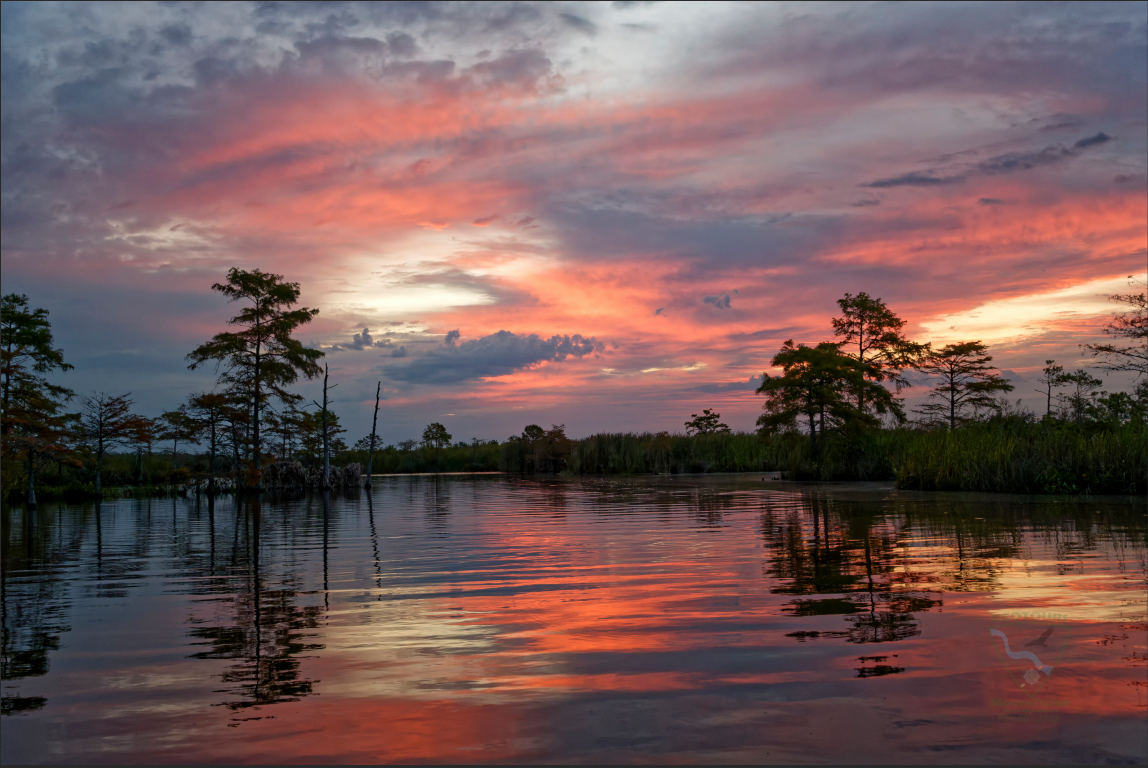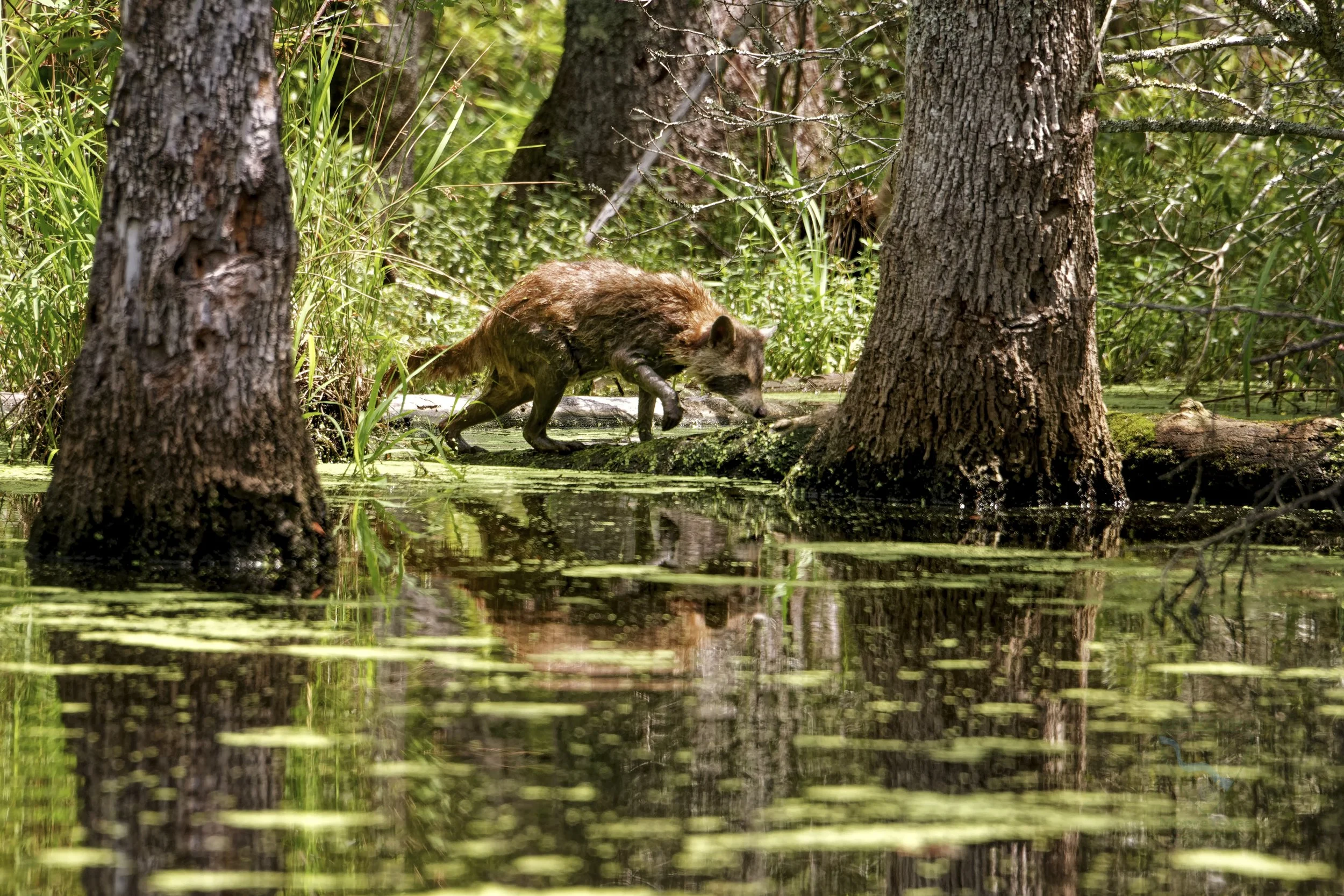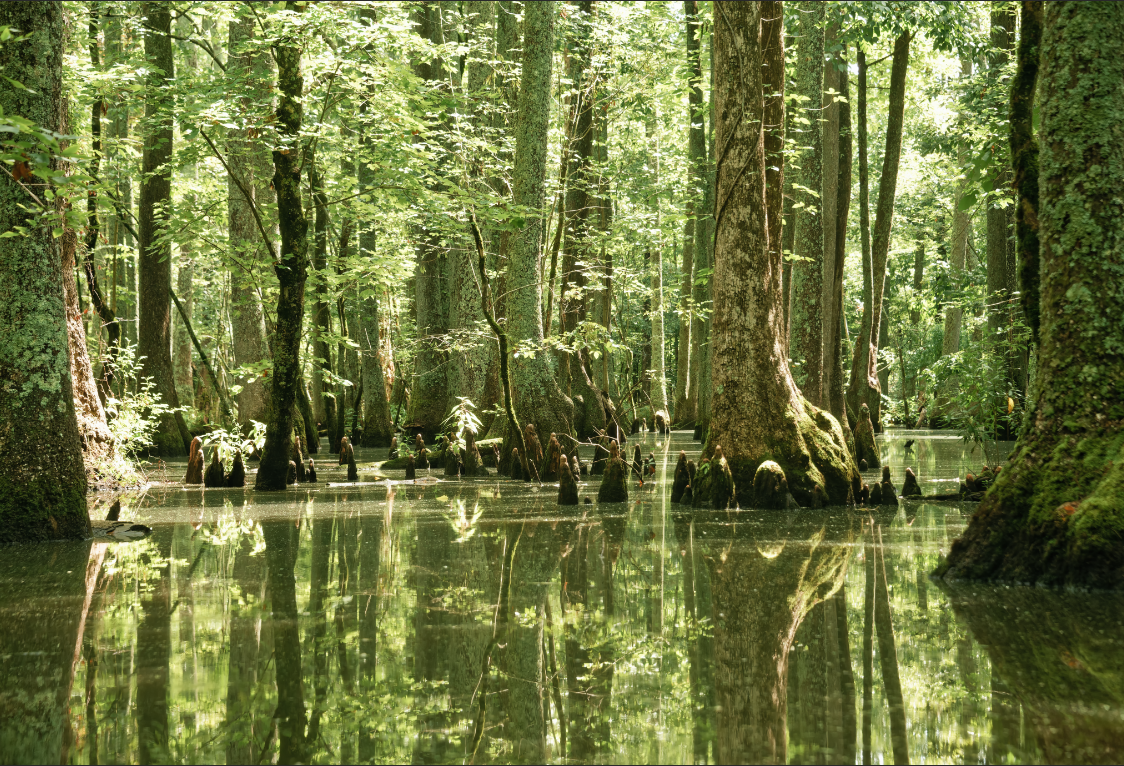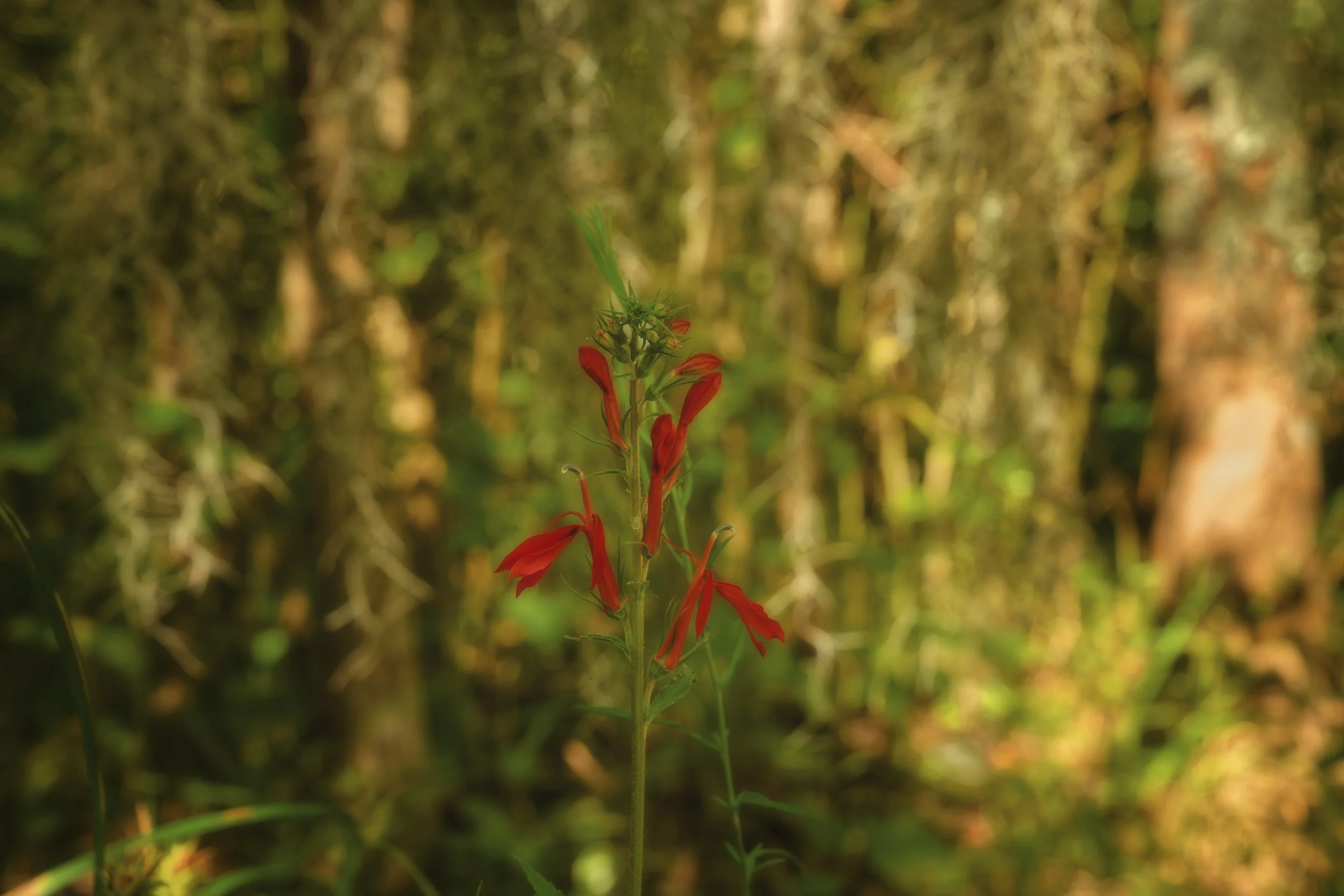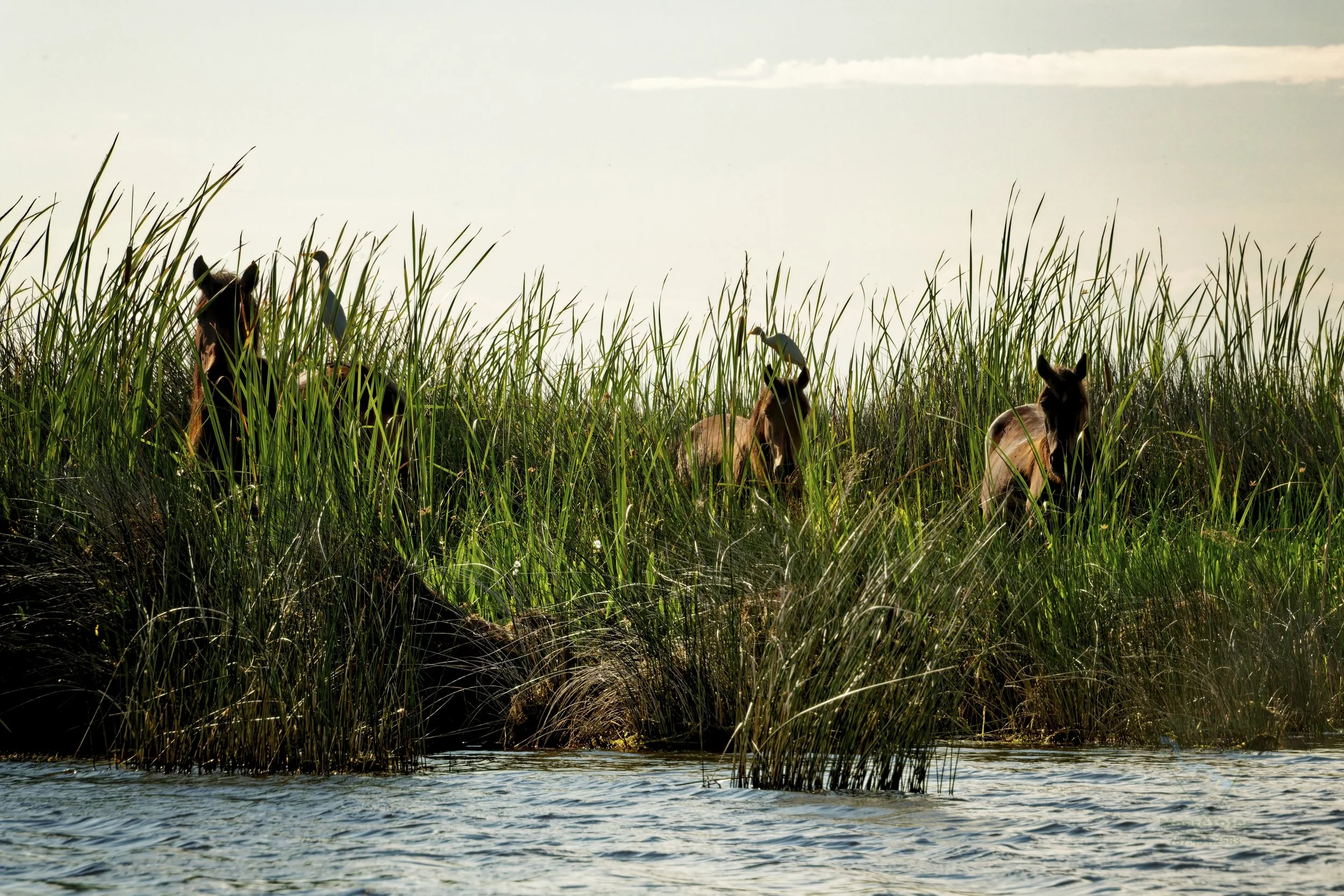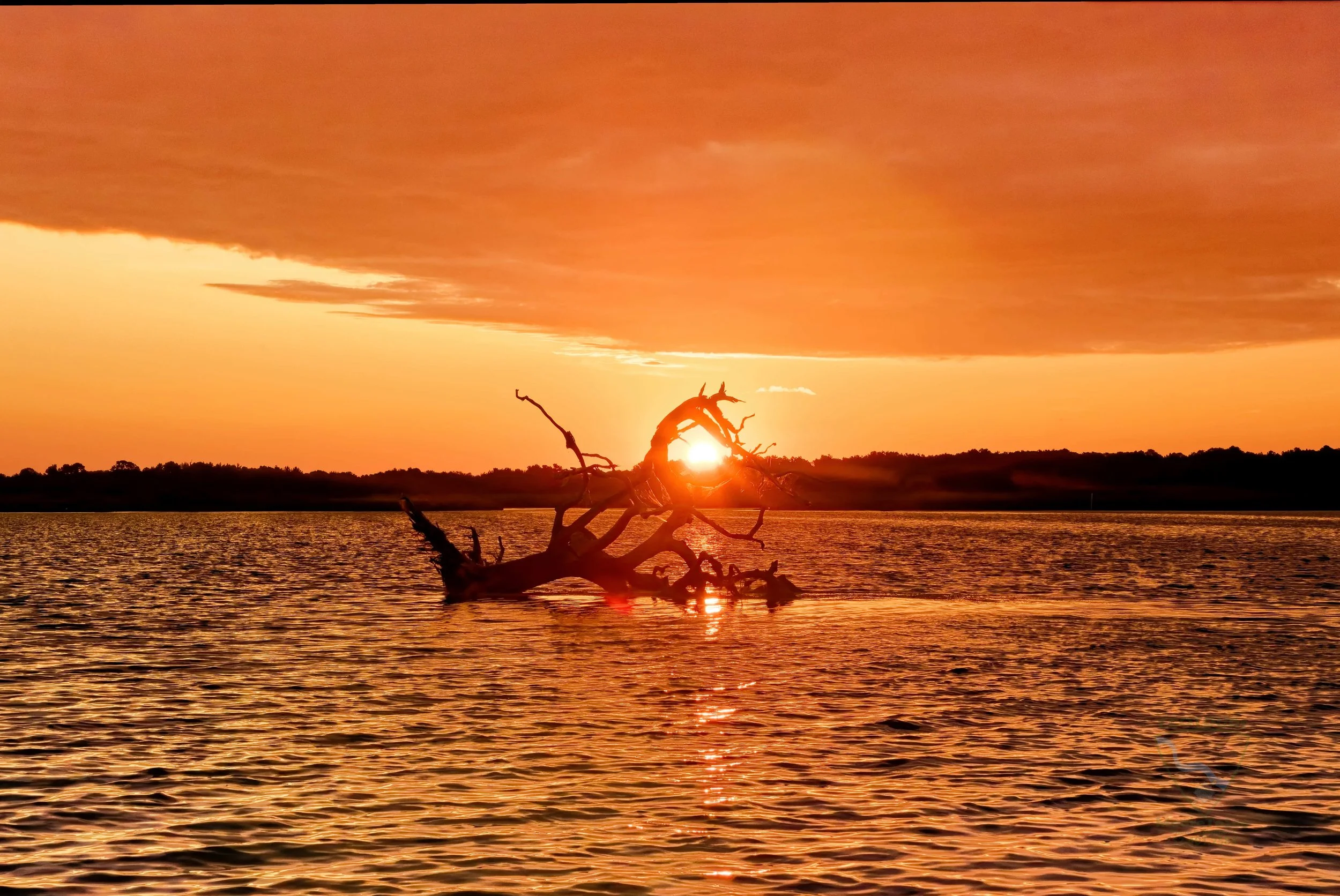Holiday Gift Idea
Give an experience this holiday season - an ecotour on the North Landing River!
The holidays are coming fast! Still looking for that perfect gift? Give your loved one an experience this year - they will remember it for years to come!
Each tour is private. I will email you a certificate that you can present and they can schedule when they’re ready!
Contact me here.
Twilight on Albright’s Creek
Between the Pungo Ridge and the Land of Promise Ridge flows a Virginia Scenic River.
Twilight on Albright's Creek- North Landing River
Between the Pungo Ridge and the Land of Promise Ridge flows a Virginia Scenic River. The North Landing is a beautiful ribbon of water that sluggishly meanders south through thousands of acres of lush wetlands. Stained, tannic water trickles from the swamps and pocosins, filtered and cleansed by the peat and marshes, forming this majestic blackwater river.
We live in a constructed world filled with atmospheres of noise. In the distance there is the sound of tires on pavement, air conditioners, airplanes, and the piercing, insistent beep-beep-beep of a backing truck. In our homes there is a television that no one is watching, the drone of a refrigerator fan, and phone notifications demanding attention that never seem to cease. But on the North Landing River, a few painted minutes before sunrise, the noise atmosphere is unspoilt, tranquil. Here, the clamor of progress is banished. Reeds rustle in the wind. A distant splash. The faint whistle of a duck in flight. The call of an owl. If twilight had a sound, I imagine it would be a hymn.
Schedule your ecotour with Moore To See Photo Expeditions to explore this environmental wonderland.
North Landing Mornings
The North Landing River in southeastern Virginia is a watery ribbon that cuts a winding path through a maze of marshes and pocosins. Unlike many rivers, the North Landing River does not start narrow and fast in the mountains of Virginia.
Morning fog on the North Landing River
The North Landing River in southeastern Virginia is a watery ribbon that cuts a winding path through a maze of marshes and pocosins. Unlike many rivers, the North Landing River does not start narrow and fast in the mountains of Virginia. Rather, it percolates up through the deep black soils and sponge-like peat of surrounding swamps, gathering and widening to form a blackwater river that eventually converges with the Northwest River in Currituck Sound.
Mornings on the banks of the river are reminiscent of an older, slower time. The air is thick and cool, heavy with the lingering fog as labradors retrieve bumpers tossed out into the coffee-colored water. The rumble of a tug boat floats across the still water as it carefully maneuvers a barge under the Pungo Ferry Bridge and small jon boats head out towards the foggy marsh, fishing poles and bobbers dangling behind the small outboard. Just as the sky begins to lighten, ducks streak low above the tall marsh grasses and in the distance, the sharp cry of an osprey breaks the silence as eagles assume their perches on the cypress trees that line the river. As the sun rises, the fog - clinging like a curtain to the shore -lifts and the soft pinks give way to blue.
Schedule your ecotour with Moore To See Photo Expeditions to explore this environmental wonderland.
What draws me to the River
he North Landing River is justly designated wild and scenic - a joy to gaze upon and a delight to travel and explore.
The North Landing River at Sunrise.
The North Landing River is justly designated wild and scenic - a joy to gaze upon and a delight to travel and explore. Though I have journeyed these waters countless times and everything is familiar, the river always feels new. The shifting light, the turn of the seasons, the misty mornings, the chance wildlife encounters—it all changes, always. Perhaps that is what draws me, to chase the subtle differences and ensure I don't miss the next fleeting moment of beauty or bear crossing. The river itself, however, remains constant as it lazes south, stunning in the rising sun.
Schedule your ecotour with Moore To See Photo Expeditions to explore this environmental wonderland.
A lone tree
A lone bald cypress on the North Landing River.
A lone tree. Surrounded by water, hanging on in the soft peat and mud. Isolated by erosion, yards from the bank on the North Landing River. Bald cypresses were one of the most sought after species of trees throughout the South and were heavily logged from colonial times through the 1900s. Bald cypress trees are found along the entire length of the North Landing River, on every tributary stream, and there are hard to reach swamps with cypress that are hundreds of years old - areas so difficult to access that they have never been logged. But this lone, lowercase cypress stands stubbornly against the odds, resisting the onslaught of three foot boat wakes from the yachts on the Intracoastal and the constant rising and falling of the river caused by wind tides.
I can’t count the number of people over the years that have expressed to me that I might be adding to the demise of the North Landing River and the natural heritage that surrounds this Virginia Scenic River by sharing images of the river. I see their point, but I disagree for many reasons. But, here are two. First, access to the river is limited. A boat or some type of vessel is required - only a very small fraction of the bank is accessible without one. Even with a vessel, most of the waters are shallow - then it gets shallower with a northerly wind, limiting access. Second, awareness can also help protect a place. As Clyde Butcher wrote, “It is (my) hope that by sharing the beauty of the region you will see the need to keep it in its natural biological condition for future generations to enjoy.” So, I suppose I am saying that by sharing these images, it might help protect the North Landing. Maybe not. Regardless, this might be one of my favorite pictures of the river.
Schedule your ecotour with Moore To See Photo Expeditions to explore this environmental wonderland.
Changing Plans
Some mornings, my plans go awry - it’s just what happens. When I’m going, I usually decide the night before where on the North Landing River I want to be at sunrise. Most often, my goal is to be in place deep in some tributary creek…
West Neck Creek Sunrise
Some mornings, my plans go awry - it’s just what happens. When I’m going, I usually decide the night before where on the North Landing River I want to be at sunrise. Most often, my goal is to be in place deep in some tributary creek when the light from the rising sun begins to paint the sky and reveal the secrets in the marshes and swamps. More often than not, I follow through with what I had intended, unless I don’t. My well laid plans are really more like suggestions to myself, not unchangeable and quickly modified in the faint predawn light. Like today. Traveling north on the river, I looked to my right and cut the engine. My plans had changed.
At the mouth of West Neck Creek where it unites with the North Landing, I drift. It’s just so quiet. The early morning mist, clammy and featureless, slips along the creek and sinks slowly back into the swamps as the sun creeps skyward. A muskrat glides silently through the water against the far bank. The marsh grasses rustle softly in the gentle Virginia breeze. If you lean in and listen closely, you might hear the angels singing.
Schedule your ecotour with Moore To See Photo Expeditions to explore this environmental wonderland.
Land of Promise
Southern Virginia Beach is different from what most people think of when they hear the name of the city. There are no hotels. No StarBucks or souvenir shops.
Southern Virginia Beach is different from what most people think of when they hear the name of the city. There are no hotels. No StarBucks or souvenir shops. No Exxons or Texacos. Hell, there isn’t even a road with more than two lanes and most roads don’t even have lines, but the ditches will swallow your Suburban. This is a place of pickup trucks and tractors, boats and duck blinds, water dogs and shotguns, farm stands and Sunday mornings in a pew. Until relatively recently, the people in this part of Princess Anne County made their living off of the land or from the water - or both. Farming. Commercial fishing and crabbing. Waterfowl guiding. People's lives were tied to the land and the water - many still are, and trust me, there is no shortage of water. The region is a study in the geography of water, and the water is different - it is not colorless. The waters are tannic and brackish and shallow and shallower.
The influence of water can be seen in many of the place names in Pungo and Blackwater. Neck is common in names - a neck being land with water on at least two sides. Charity Neck. West Neck. Buzzard Neck and Morris Neck. And before there were roads there were landings. Now, the roads are named for landings. North Landing and West Landing. Mill Landing. Campbells Landing. Back Bay Landing and Public Landing. Naturally, several roads are also named for the many waterways. Indian Creek and Indian River. Muddy Creek, Nannys Creek, Blackwater and Head of River Roads. Even most of the few places to eat are named for things related to the water: Blue Pete’s; Redhead Bay Cafe; Back Bay Market; Blackwater Trading Post.
Southern Virginia Beach is rural and an environmental wonderland for lovers of nature and water. And it is a Land of Promise, just as the ridge and road names predict.
Schedule your ecotour with Moore To See Photo Expeditions to explore this environmental wonderland.
My Mansion
Time spent on the North Landing River is a peaceful and scenic experience, and most days I have the river entirely to myself. Occasionally, a fisherman in a small flat bottomed boat will appear around the bend in one of the many creeks that feed the North Landing.
Sunrise on the North Landing River
Time spent on the North Landing River is a peaceful and scenic experience, and most days I have the river entirely to myself. Occasionally, a fisherman in a small flat bottomed boat will appear around the bend in one of the many creeks that feed the North Landing. It is the perfect place to take things slow, to unwind after a long week or - in my case - the perfect place to start the day. In the warm, golden wash of twilight, the sounds of nature are the only disruption to the silence, though it is a welcome one.
The river is my mansion and the wetlands are my gardens. The river is my exotic destination, the antithesis of the asphalt and concrete north of the Pungo light - a separation of the wild from the urban. This is my wildlife safari. Every bend of the river, every unseen splash and warning bark of an otter is a testament to the spirit of this wild, beautiful river.
Schedule your ecotour with Moore To See Photo Expeditions to explore this environmental wonderland.
Feathers & Fur
Swamps are magical places. Forbidding to some, but to those who venture, they reveal a world full of life and secrets.
Barred owl on the North Landing River
Swamps are magical places. Forbidding to some, but to those who venture, they reveal a world full of life and secrets. The swamp is no wasteland but a sanctuary—a place where beauty and wonder are written in feathers and fur and shadows, a true sanctuary of nature’s endless wonder. Primitive and untouched, nature's wild artistry is on full display in this hidden world, inviting those who dare to look closer to discover its captivating charm.
In the light that filters through the cypress and gum, a barred owl watches silently from the tangled canopy, a patient guardian of ancient mysteries. A great blue heron rests and waits, watching the dark, still water, and silently, river otters pause and inspect the intruder.
Schedule your ecotour to explore this environmental wonderland.
Great blue heron on the North Landing River
River otters on the North Landing River
Rare Encounters
The North Landing River is a wildlife enthusiast's paradise and is always a pleasure to explore.
King rail on the edge of the marsh.
The North Landing River is a wildlife enthusiast's paradise and is always a pleasure to explore. Gliding along the water, you'll often spot familiar species like bald eagles, great blue herons, and ospreys soaring overhead. But the river holds its secrets, and you're always hoping to catch a glimpse of a rarer creature, like a shy mink or a playful river otter. Occasionally, you might even stumble upon something truly uncommon, like the elusive king rail or a coyote silently stalking the marsh. The river is a constant surprise; you never know what's waiting just around the next bend.
Schedule your ecotour to explore this environmental wonderland.
The Dragon Tree
It is said that people sometimes hear the secret of the land. It is a sound that comes from the marsh, from the very soul of the land and sounds like a distant drumbeat that floats across the shallow waters of Currituck Sound…
The Dragon Tree
It is said that people sometimes hear the secret of the land. It is a sound that comes from the marsh, from the very soul of the land and sounds like a distant drumbeat that floats across the shallow waters of Currituck Sound on still, windless days. Folklore has it that it is the Devil beating his drum and to hear it is a sign of impending tragedy.
But what if it wasn't the Devil making that distant, beating sound? What if the sound comes from something ancient, a long-forgotten guardian of the Sound? A creature so hideous and monstrous it disguises itself as a gnarled live oak, its roots sunk deep in the earth and its trunk twisted into a reptilian form?
Perhaps the sound isn't drums at all, but the slow, ominous heartbeat of this creature coming through the water, seemingly from everywhere and nowhere. The rumbling sound might be a message, a warning, not a punishment. Perhaps the ancient creature is a benevolent spirit, not an evil beast. Perhaps it is old and weary, its body a part of the landscape and its resounding heartbeat an attempt to warn the good people of Currituck - a misunderstood protector.
Or, maybe not!
Schedule your ecotour to explore this environmental wonderland.
Sunrise on a River
It’s not always the sunrise. The sun rises every single day and some days are more dramatic than others, while other days are more of a flat, uninspired gray.
Sunrise on the North Landing River
It’s not always the sunrise. The sun rises every single day and some days are more dramatic than others, while other days are more of a flat, uninspired gray. Of course, most of us are happily entertained when the morning sky is afire with the magical colors of daybreak. But, often, it’s more about where you are experiencing the sunrise than the event itself.
Sunrise on the beach is nice, but I prefer for there to be ‘something’ in the foreground. A surfer, maybe, studying the waves or a couple walking slowly along the edge of the water. My favorite location to watch the start of the day, however, is on the North Landing River. The bald cypress trees stand like sentinels along the shore and marsh grasses line the river, bending gently in the morning breeze, filling the air with a soft rustling. Frogs call from their secret places and wood ducks descend from the trees. A splash somewhere out of sight. The air smells of the earth and the sky is colored by heaven.
Schedule your ecotour to explore this environmental wonderland.
“He who scratches..”
The North Landing River has a secret. It is whispered that it is the most biodiverse place in Virginia east of the Blue Ridge Mountains and has the highest concentration of rare species this side of the Appalachians.
The North Landing River has a secret. It is whispered that it is the most biodiverse place in Virginia east of the Blue Ridge Mountains and has the highest concentration of rare species this side of the Appalachians. It is not hard to understand why when you consider that there are tens of thousands of acres of wetlands in the area. The North Landing River Natural Area Preserve - the first of its kind in the state - alone is over three thousand acres and The Nature Conservancy owns another six or seven thousand acres.Approximatley 40% of all plants and animals depend on wetlands for survival and breeding and that makes this river a wildlife haven. The North Landing is also on the Atlantic Flyway which brings hundreds of species of birds from as far as the Arctic and the Tropics.
One of the common mammals you may see swimming or scavenging along the shore is the raccoon. Many North American tribes characterized the raccoon as a trickster and mischief-maker. Its Latin name, Procyon lotor, translates to “before the dog washer.” The word raccoon came from the Algonquin people and means“he who scratches with his hands.”
The next time you are on the North Landing River, keep your eyes peeled to the shoreline. It is there that you are most likely to see one of the mammals that dwell on the river and its surrounding wetlands. Most of these animals are crepuscular, so early morning and late afternoons are likely to be more fruitful. Personally, I have seen most mammals in areas that are more “woody” than “marshy.” “He who scratches with his hands” can be seen digging in the shallow water for crawdads and other crustaceans.
Schedule your ecotour to explore this environmental wonderland.
Spanish moss and Geese
The Choctaw believed that Spanish moss originated from the hair of the daughter of the ‘Father of a Thousand Leaves’ after she was murdered. The Father of a Thousand Leaves demanded that all of the trees in the land mourn the death of his daughter.
Spanish moss has had many uses throughout the millennia, from pottery making by Native Americans to providing blankets during the Civil War. It also had its place in the modern world, serving as insulation, a binder in construction materials, and even as stuffing in automobile seats. The use of Spanish moss diminished as synthetic fibers were developed, but animals still use the epiphytic flowering plant as nesting material. The goslings that hatch in this nest on a tree island in a swamp along the North Landing River will start life in luxury.
Schedule your ecotour to explore this environmental wonderland.
On the way to the River
I wondered how long it would take for that one strand of Spanish moss to grow long enough to reach that cypress knee.
The clerk at the convenience store was less than friendly and certainly not interested in small talk. His cell phone was laying on the counter, an Instagram Reel looping. I think I interrupted his scrolling session by buying a cup of coffee. On the way to the river, I was tailgated by a mid-size silver SUV - there seem to be thousands of them on the roads these days. The driver, obviously in a hurry, was doing her best to attempt to pass me. I could see the displeasure in her face in my rear view mirror, frustrated in the glow from the phone that she held in her right hand reflecting off of her eye glasses. Further down the road past the Pungo light, a red sedan sat parked on the side of the pavement. It was not really parked, more like stuck in the soft mud on the far side of the ditch, the front end of the vehicle just in the soybeans. I imagined the driver fell asleep or was distracted, perhaps by the same reel the clerk was watching. But I was in no hurry. Sunrise was still a half hour away. I had my coffee, the latest international news played on the radio, and I was headed to my escape place - the North Landing River.
The water was high that day. The winds were blowing from the south, pushing water up from the Albemarle Sound, allowing me to maneuver my boat further up the small creeks that feed the river. With the outboard motor off and the frogs giving way to the cicadas, I wondered how long it would take for that one strand of Spanish moss to grow long enough to reach that cypress knee.
Schedule your ecotour to explore this environmental wonderland.
Birds in the Swamp
One may observe many different species in each zone, and sometimes you are the one being watched.
The North Landing River is a magical ribbon of water in Southern Virginia Beach. A true southern blackwater river, it flows from the swamps and pocosins in the southern part of the city and joins the Currituck Sound just over the border in North Carolina. The habitat along the main stem of the river is primarily pocosin in the northern stretches and marsh in the southern. But if you explore the many creeks along the North Landing, you will encounter a third wetland type, forested swamp. One may observe many different species in each zone, and sometimes you are the one being watched.
Schedule your ecotour to explore this environmental wonderland.
An Extinction of Experience
We do not get out into the natural world as often as we once did. It’s not intentional, but more of a creeping indifference. A recent UK study found that the human connection to nature has declined 60% in the last 200 years.
We do not get out into the natural world as often as we once did. It’s not intentional, but more of a creeping indifference. A recent UK study found that the human connection to nature has declined 60% in the last 200 years. Essentially, many of us in our modern, western world seem to have lost that bond with the natural world. It may even be that it’s not lost, but rather not cultivated. The study found that two of the largest contributors to this disconnection with nature are urbanisation and the loss of wildlife in our neighborhoods. But the largest factor is the failure of parents to teach children to appreciate the natural world. In order to teach a love for nature, one must be in nature. All of the way in. Watching a wildlife series on a streaming service is a passive experience and can not replicate the feel of walking on a muddy path in the woods, the beauty of the sunrise on the beach, or the sounds and smells of canoeing in a swamp amongst the cypress knees.
I see it every morning. The bus stop is full of elementary-aged kids, but where are they in the afternoons and on the weekends?. They are not to be found on the streets and in the fields in this neighborhood. They are either out in the forests with their parents or in their homes, their faces bathed in a blueish glow from a screen they are watching. I suspect the latter.
There is an “extinction of experience” taking place. But that is easily corrected, isn't it? Get outside. Take your children or grandchildren hiking in the woods or go fishing. Book an ecotour or swim in a river. Make a connection to nature and build on it.
Schedule your ecotour to explore this environmental wonderland.
A Blast of Red
Swamps are dark places. Black gums, cypresses and tupelos tower above the dark tannic water, shutting out all but the few rays of sunlight
Swamps are dark places. Black gums, cypresses and tupelos tower above the dark tannic water, shutting out all but the few rays of sunlight that manage to break through the thick canopy and cut through the shadows. In the interior of the swamp, inky, shallow water flows slowly under the giants, meandering between the buttressed trunks, snags and cypress knees. The animals that dwell in this darkness are cautious and stealthy. Otters swim in graceful silence, always hunting, and beavers work to maintain this realm of wetness. Raccoons and possums search the tree islands for meals while mink busily hunt every corner of the swamp, above and below the black water. But the hunters are also the hunted. From above, owls watch patiently and bobcats drift like shadows through the undergrowth.
In this world of shadows and decay, vibrant colors are a disadvantage. Here, life is painted in earthy tones, but occasionally a rare blast of color interrupts the muted palette. Against a backdrop of Spanish moss, a gorgeous cardinal flower blazes.
Schedule your ecotour to explore this environmental wonderland.
Where’d you take that picture?
“Where’d you take that picture?” I get that a lot. By now, after many years of exploring the rivers, bays, creeks, marshes, and swamps…
“Where’d you take that picture?” I get that a lot. By now, after many years of exploring the rivers, bays, creeks, marshes, and swamps of southern Virginia Beach, those who know me know that, unless I say otherwise, all of my pictures are from south of Indian River Road down to the northern portions of Currituck Sound. I have not been everywhere - there are certainly many local boys that know many locations much more intimately than I ever will - but I do try to find new places and push my limits. I remember one particular exploration where I thought that perhaps I had taken it too far. I waded through a swamp for three hours in deep, boot-sucking mud to reach a hummock that I had spotted on a map. By the time I reached the hard surface road six hours after I started, I was exhausted and my heart was pounding out of my chest. I’m glad I went, and I’ll go again. But I love it.
“Where’d you take that picture?” Somewhere most have never been nor will ever see. Well, unless they go on one of my ecotours. These are places where dark water flows between cypress knees under the shade of giants, where otters swim, bobcats hunt, moss sways from the trees, and horses graze on marsh islands. I do go to some places many times over, like the marshes near Old Currituck Inlet. When I’m lucky, there are wild horses in the marsh.
Schedule your ecotour to explore this environmental wonderland.
AI Can’t Generate an Experience
In what seems a very short time, AI has infiltrated most aspects of our lives.I don’t even have to explain what AI stands for. It is everywhere.
In what seems a very short time, AI has infiltrated most aspects of our lives. I don’t even have to explain what AI stands for. It is everywhere. Analysing data, automating repetitive tasks. AI is in our factories and hospitals and is even driving cars in some states. Don’t get me wrong, AI can be very useful to all of us in so many ways. It can generate workout programs, answer emails, translate languages, create art, write stories - hell, I could have used Gemini to write this for me! From what I am reading, people even have digital companions now. Relationships. Relationships? But there are limits. AI comes to you through the motherboard, not your mother. AI can’t make you experience things. It can create an image of asunrise, but it can’t put you on Knott's Island Bay as the sun creeps above the live oaks and pines of False Cape and a warm, late summer breeze with a hint of ocean salt gently sways the marsh and sighs against your skin. It can’t do that. Nor would you want it to. On my ecotours I show you things and take you places that must be seen, heard, and sensed. There is magic here in the early morning light. It’s in the air and in the water and in the moment. AI can do a lot, but it can't make you feel the magic of life.
Schedule your ecotour to explore this environmental wonderland.


